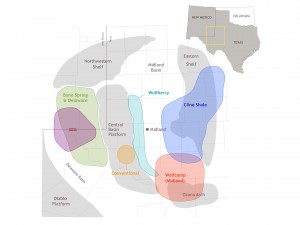Those living on the far eastern side of the Permian Basin have watched with interest as activity has surged in recent years with the development of the vertical, multi-zone Wolfberry play in the heart of the Basin.
With the Midland-Odessa area enjoying remarkable growth, cities on the eastern shelf of the Permian Basin, such as Abilene, Sweetwater, Snyder, Rotan, and Roby, have wondered whether the frenzied drilling activity would eventually reach them. Well, the answer appears to be yes.
The emerging Cline Shale has become the latest horizontal oil shale target, sparking comparisons to the Bakken Shale in North Dakota, the Eagle Ford Shale in south Texas, the Mississippi Lime play in Oklahoma and Kansas, the Granite Wash in the Texas Panhandle and western Oklahoma, and the Wolfcamp and Bone Spring in the Permian Basin. More than one oil and gas publication has called the Cline Shale one of the hottest new shale plays in the United States.
The anecdotal evidence that something was brewing has been obvious for months now to those living on the eastern side of the Basin. From a cotton farmer in Fisher County leasing his land for top prices to a shuttered cotton gin near Roby leasing warehouse space to a service company to store sand that will be used in the hydraulic fracturing process, the only thing seemingly missing has been the drilling rigs.
A new well service company has moved into Sweetwater recently, and Devon Energy has reportedly leased office space in Abilene. Officials representing the taxing entities in Scurry County held a town hall meeting Oct. 30 in Snyder to provide community updates and discuss how the area needs to handle the anticipated Cline Shale oil boom.
“For us to be prepared we have looked at other places where this has happened,” Scurry County Judge Ricky Fritz told the Lubbock Avalanche-Journal. “We started with the Barnett Shale and the Eagle Ford Shale. We are not deceiving ourselves about who we are and what we have and why we have it. We have been through the oil booms and busts before. But, by the same token, we need to take a look at other counties that have been through this and see what they did right and what we need to improve on.”
So what is the Cline Shale?
The Cline formation, at approximately 6,000 to 9,000 feet, is one of a number of deeper zones, along with the Fusselman, Strawn, and Atoka, that lie below the Wolfcamp, which has been a target for horizontal drilling in the Permian Basin. The Spraberry starts to thin out in Glasscock County, some 35 miles east of Midland, where vertical wellbores have previously extended into the Wolfcamp and the other deeper zone s.
s.
Three-Finger Black Shale
Cliff Smith, the owner of L.C.S. Production, Smith Pipe, and SPA Drilling in Abilene, said smaller operators and geologists in Texas Railroad Commission District 7B have known about the Cline Shale for years. Only they called it the Three-Finger Black Shale.
“It was a known oil and gas show while we were drilling for the Palo Pinto Reef,” offered Smith, who acknowledged the Three-Finger Black Shale was never considered economic. “The rock was so tight we couldn’t make it productive.”
Then the new technology of horizontal drilling and multi-stage hydraulic fracturing opened up new reserves and re-opened old areas. When drilling activity began in Glasscock County, the formation was called the Cline Shale, according to Smith, so that name has now been adopted for the Three-Finger Black Shale.
Smith said he believes the Cline Shale extends all the way from Sterling and Glasscock County to the Abilene area in Taylor County, including Howard, Mitchell, Nolan, and Fisher counties. He added that it may extend even farther east and north into Jones and Shackelford counties.
Making a big splash
Although many of the key players in the Permian Basin are now starting to target the Cline Shale, Devon Energy appears to be the 300-pound gorilla in the room. In September, Devon closed a $1.4 billion joint venture agreement with Sumitomo covering 650,000 net acres in the Permian Basin, which includes more than 500,000 acres prospective to the Cline Shale.









